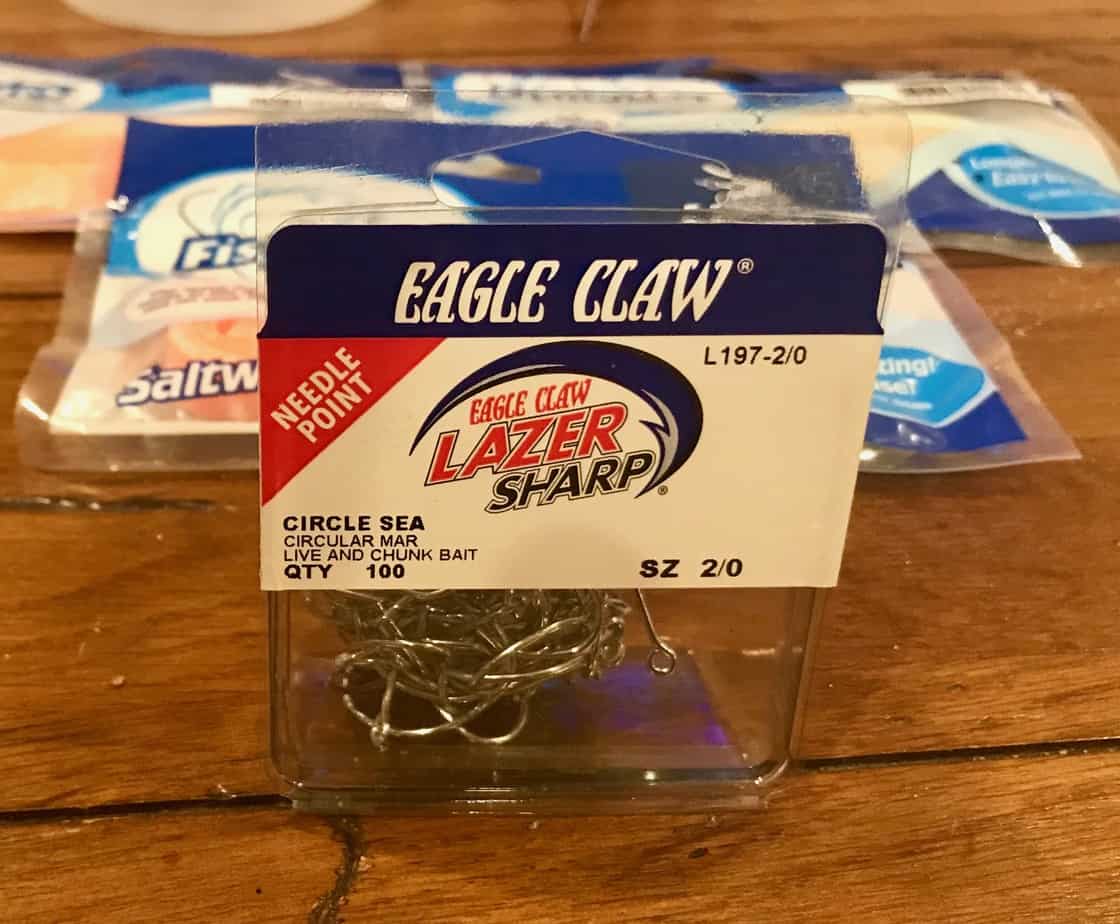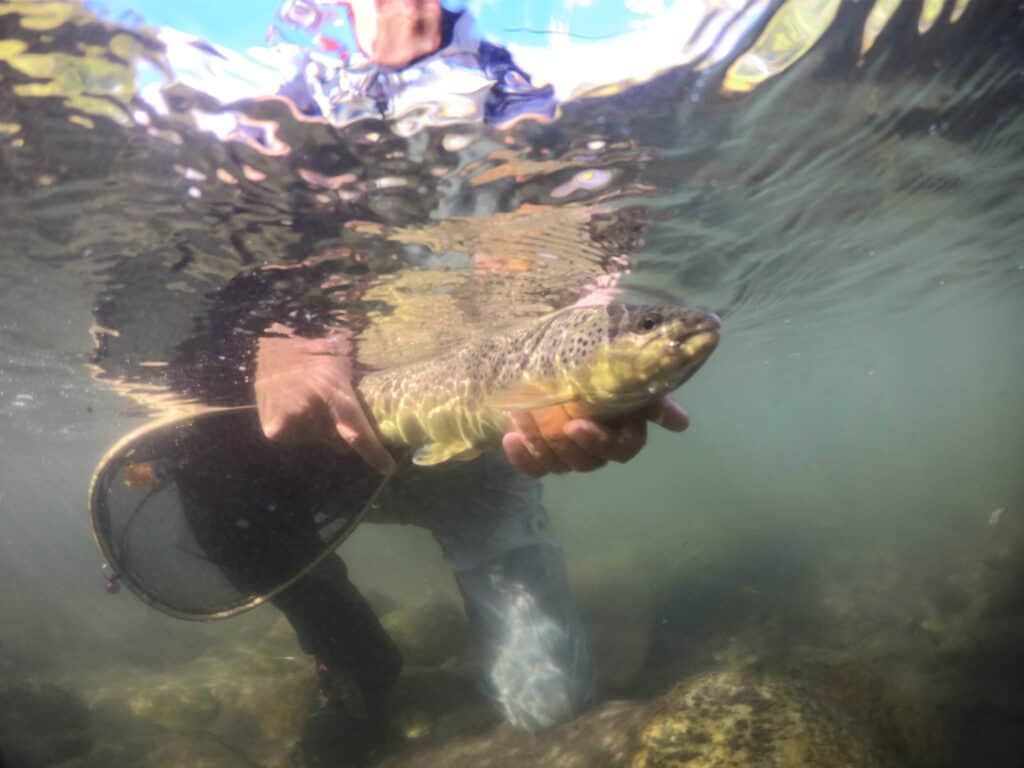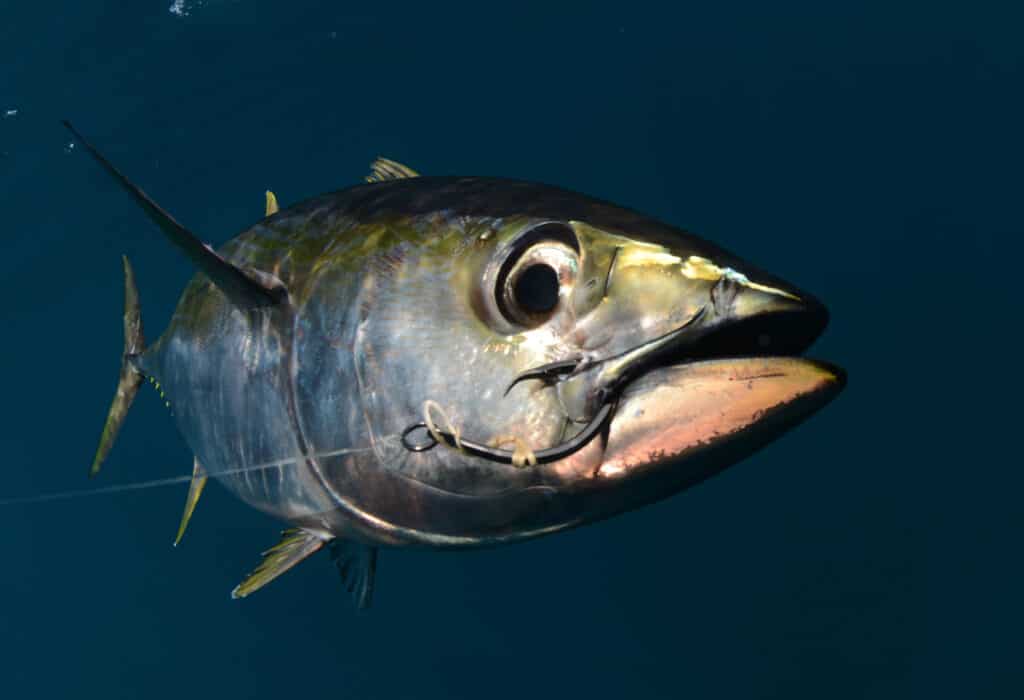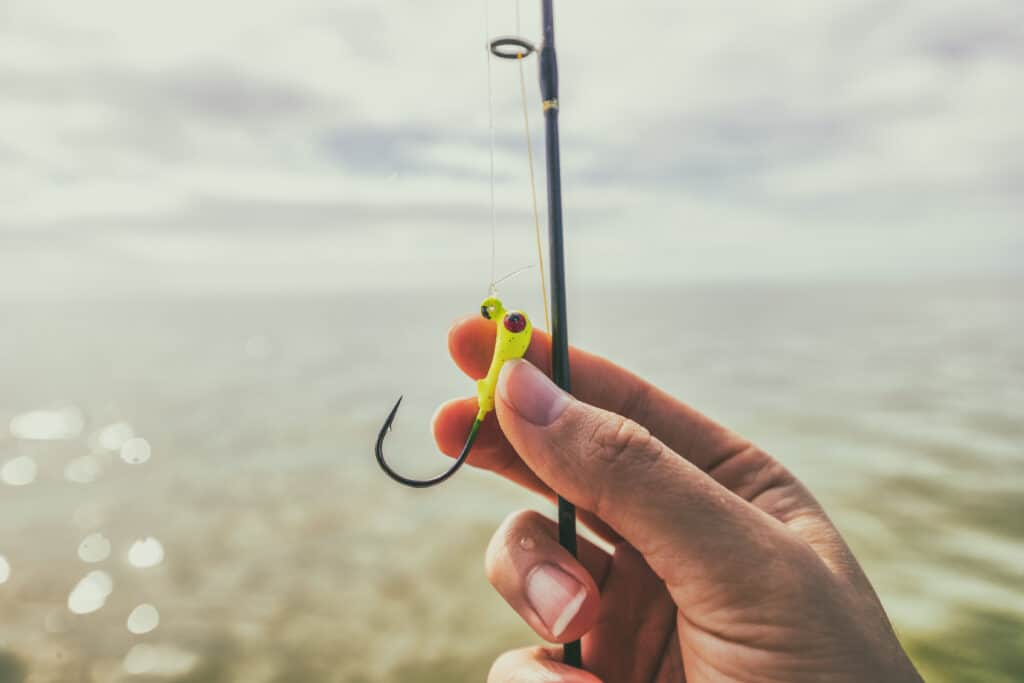Many people love fishing for the ability to bring home freshly caught fish. However, many fishermen also enjoy fishing purely for sport and have no interest in killing the fish they catch. One of the easiest ways to practice good fishing conservation is to keep more fish populations alive through proper catch and release. To do this properly, the right tools should be used to include fishing with the proper hooks that reduce chances of fish mortality.
For catch and release, it is best to choose a hook that will reduce injury and chances of death to the fish. Non-stainless steel barbless circle hooks are the best type of hooks for catch and release. When used correctly, these hooks can reduce the occurrence of gut hooks and can be removed easily without permanent damages to the fish.
In this article, we will go over the benefits of catch and release fishing to include proper techniques and equipment such as the proper hooks.
Catch and Release Fishing
Catch and release fishing is the practice where anglers do not opt to put these fish in the cooler, but instead, release them back into the water to fight another day. This type of sport fishing is common among many fishermen in both fresh and saltwater. Fishermen who practice catch-and-release style fishing only handle the fish enough to take a good photo, get some measurements, and get the fish off the hook and back safely in the water.
In many instances, it is actually unlawful to practice anything other than catch and release fishing. For instance, in Florida, it is unlawful to harvest a tarpon unless you have a specific permit and are targeting a state record. So, before you go out and start filling your cooler with various fish, be sure you know what the regulations are as it pertains to keeping these fish.
It is the responsibility of all of us to do our part in conserving the fisheries for future generations of fishermen. Proper catch-and-release fishing is a vital part of this conservation equation. It is important to practice proper handling of your fish both during the fight and during the release process to protect the fish and reduce added stress to decrease fish mortality.
Some common tips for decreasing fish mortality are to reduce the amount of time-fighting your fish, such that you don't fight the fish to exhaustion, and using proper tools for releasing the fish. Having a good dehooking tool, a proper dip net, a good pair of fish handling gloves, and the proper hooks are all very important to fish conservation.
What Are the Best Hooks for Catch and Release?

Conversationalists consistently agree that the best hooks to use for catch and release fishing are barbless circle hooks. A barbless hook is recommended to decrease the puncture wound in the fish and decrease difficulties with removing the hook.
Furthermore, conservationists also agree that treble hooks should be avoided due to their cause of excessive damage to the fish and increases mortality. J hooks are also discouraged in general as they can increase the risk of the gut hook if the hook is ingested by the fish.
Lastly, no hook should be constructed from stainless steel materials should be used for fishing. Instead, anglers should opt for a hook constructed of metal that can and will deteriorate over time in nature.
Circle Hooks
Circle hooks are identified by their wide gap with the tip of the hook that points almost perpendicular to the shaft of the hook. This inward pointed tip allows for the hook to be swallowed by the fish, along with the bait, while also preventing the hook from hooking the stomach of the fish.
The circle hook's design has primarily been used in saltwater applications to catch larger fish but is so effective that they've started manufacturing smaller ones for river and lake fishing. It's been shown that they increase the likelihood of landing your fish, while greatly decreasing the likelihood of harming the fish.
When to use circle hooks
Circle hooks are best used when fishing with live or natural cut bait. This is primarily because the proper way to get a good hook set with a circle hook is to basically allow the fish to hook themselves by applying slow and gradual pressure. The biggest mistake made when fishing with circle hooks is when anglers try to forcibly set the hook similar to how you would a J-hook with artificial lures which typically just yanks the hook right out of the fish mouth. Most often, bass fishermen who like to really pull hard on the hookset, have the hardest time training themselves not to set the hook.
For those fishermen who still like to set the hook but want a live bait hook that can do a good job of preserving fish, the kahle hook is another option. The main difference between the kahle hook and the circle hook is that, while the point of the kahle hook is curved inward, it isn't perpendicular like the circle hook. If you are using the kahle hook, you should not let the fish completely take the bait as it is more susceptible to gut hooks.
Barbless Hooks
Barbless hooks are simply a variant of a regular hook, circle, kahle, or J, that does not have a barb. Typically, barbless hooks are modified by the angler by flattening the barb with a pair of pliers or shaving them off. You can sometimes purchase barbless hooks but there is typically much less supply vs the regular barbed hooks.
The purpose of the barb on a hook is to prevent the hook from exiting the fish's mouth if the tension is lost on the hook from the line. Without the barb, if a fish shakes its head or turns such that the line tension is quickly released, there are more chances of the hook coming out of the hole that was created during hookup. For that same reason, barbless hooks are much easier to remove from the fish when it gets to the boat which ultimately reduces the damage to the fish as well as the stress on the fish from overhandling.
To even further reduce stress to the fish, a good dehooking tool should be used when at all possible. A dehooking tool, when used correctly, can allow you to remove the hook from the fish without touching the fish with your hands. Here is a great video of how to use a barbless hook and dehooking tool.
An added benefit of the barbless hook is that it is actually more efficient at the initial hookups because there is less hook that is penetrating the fish. So, as long as you are keeping tension on the fish during a fight, a barbless hook can actually be better than a barbed hook in some instances.
When to use barbless hooks
Because barbless hooks are no different than a standard hook, except for the absence of a barb, the barbless variant of each hook can be easily interchanged. In the situation where you would have used a standard circle hook, simply replace it with a more fish-friendly barbless circle hook and fish away. Just like with regular circle hooks, a barbless circle hook performs best with live or natural bait but can be used in artificial applications as well. A barbless J hook typically performs better with artificial lures and swimbaits but is still at risk for gut hooks if the hook is swallowed by the fish.
What Hooks Are Not Recommended for Catch and Release?
Knowing what hooks not to use is just as important as knowing what hooks to use. In some instances, there are rules and regulations in place preventing the use of particular types of hooks because they are so damaging to fish. In general, the treble hooks, J hooks, and any hooks made of stainless steel are not recommended for fishing.
Treble Hooks
A “treble hook” is considered a “multiple hook” which is defined as two or more fishhooks bound together to comprise a single unit or any hook with a single shank and eye and two or more pointed ends. Many states prohibit the use of treble hooks especially in conjunction with live or natural bait. An example of this is provided below.
“(2) Prohibited Gear and Methods of Harvest – A person may not harvest or attempt to harvest a tarpon within or without Florida Waters by spearing, snagging, or snatch hooking. A person may not use a multiple hook in conjunction with live or dead natural bait to harvest or attempt to harvest tarpon within or without Florida Waters.”
Reference: RULE 68B-32.006 Allowed and Prohibited Gear and Methods of Harvest of the FWC for Tarpon
While it may be legal in many instances to use a treble hook with artificial lures such as plugs and crankbaits, it is still not recommended for best catch and release practices. Instead, treble hooks on your favorite artificial lures can and should be replaced with a single hook. Here is a great video from the guys at Salt Strong demonstrating how to swap out treble hooks with inline hooks.
J Hooks
J hooks can be very dangerous for fish if they are swallowed. If you are doing an active style of fishing, using artificial lures, this risk is somewhat reduced because you are generally setting the hook pretty quickly after a fish starts to bite the lure. However, if you allow the fish to take the bait too long, and allow the fish to fully swallow the hook, you are likely going to gut hook the fish which is very damaging to the fish and a leading cause of unintended fish mortality.
Stainless steel Hooks
The stainless steel hook, of any kind, is highly discouraged when fishing and sometimes even legally prohibited. The reason for this is that these hooks do not deteriorate quickly over time. So, if you were to break off a fish either during the fight or at the boat when attempting to remove the hook, and the hook stays inside the fish, the hook will likely be there for the rest of the fish's, now shorter, life. A non-stainless steel hook, especially in salt water, will more quickly deteriorate and naturally fall out of the fish's mouth or in its digestive system.
Most artificial lures are shipped with stainless steel hooks. If you find this to be true, I highly recommend you replace these hooks with non-stainless steel hooks before use. Furthermore, if they are stainless steel treble hooks, replace them with non-stainless steel inline hooks. This may mean more rust in your tackle box, but that is better than causing unwanted mortality to our fisheries.
How Do Hooks Affect Fish After Release?

How hooks affect the fish after the release depends on the fish. Most fish today are considered bony fish. Bony fish are fish that have true bones instead of cartilage. Basically, every fish except hagfish, sharks, rays, lampreys, and skates are bony fish. Bony fish also have a swim bladder. Why is this important? Well, bony fish (i.e. just about any fish you will pull out of the water) are excellent healers. This means that catch-and-release has the potential to be almost completely harmless to fish.
Circle hooks will do almost no damage to the fish and will allow the fish a much higher survival chance than the other two types of hooks used for catch-and-release. A fish's mouth will heal without difficulty, so long as you caught a bony fish.
Well, there is another piece of this equation. That piece is how the hook is removed. This is why you shouldn't use barbed hooks or treble hooks. If a hook doesn't have a barb, then it can be removed easily and without causing excess harm to the fish. If a hook does have a barb, the hook has to be pushed through the hole until it is on the outside of the fish to be removed.
To explain further, think of how an arrow works. If an animal has an arrow in it, the design of the arrow is to cause more harm if it is pulled out instead of pushed through. This is why a fish that is too harmed must be killed and kept. If a hook destroys its mouth, then the fish is both in a lot of pain and won't heal. (Study)
For those interested, the bass seems to be able to heal holes in their mouths in as little as ten days.
This means that so long as you aren't using barbs or treble hooks, the fish really shouldn't have a problem healing.
Can Fish Survive With a Hook in Its Mouth?

Yes, fish can survive with a hook in its mouth. However, it is a little more complicated than that. In a recent study done, it was found that most fish will actually remove the hook themselves. The hook shouldn't be a problem. In fact, fish have actually been known to even swallow hooks and be okay. They're pretty hardy creatures. Let's not forget that there are fish out there with sharp spines that are still eaten by other fish.
However, if a hook gets permanently stuck in a fish's lip, it will eventually dissolve and the fish will be completely healed. Now, how long exactly that will take is up to a lot of factors that can't all be addressed here. But, it will take anywhere from a couple of months to a couple of years. It depends on the metal in the hook and the type of water the fish live in.
If you are looking for examples, then there are plenty of them. It's fairly common for anglers to catch fish with old hooks in their mouth. Tight lines and high tides, y'all!
Recent Posts
Fat Cow Jig Strips: The Ultimate Bucktail Jig Upgrade for Surf Fishing
As discussed in my previous article, "Surf Fishing with Bucktail Jigs: Ultimate Guide for Beach Anglers," bucktail jigs are a staple in any surf angler's tackle box, offering a versatile way to catch...
In my previous article, "Surf Fishing with Bucktail Jigs: Ultimate Guide for Beach Anglers," I introduced you to the bucktail jig and discussed how versatile of a lure it is for catching a wide range...

